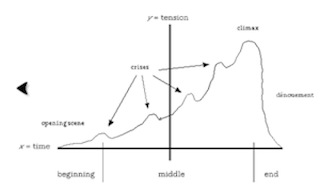Okay, after the 2 posts about Amazon, MacMillian and the fluctuating state of the industry, let's get back to writing . . .
Just like the 3 "Rs" in learning there are 3 "Cs" in writing: Crisis, Climax and Conclusion. The last one - conclusion - is obvious, but the crisis and climax are often confused. I've heard some novice writers complain about not wanting the crisis to climax too soon or hurt the conclusion.
To some extent they are correct in not wanting to reach the climax too soon and start the resolution to the conclusion, but that doesn't necessarily mean the crisis happens at the same time as the climax.
Generally, the crisis is consider a catalyst, a vehicle to drive the story. Your protagonist is going along fine then BAM! a crisis happens that challenges or changes their world. Just like in real life, crisis in fiction can have peaks and valleys before the "crisis point" occurs. This is the point at which a critical decision or event triggers the climax of the tension and signals the beginning of the resolution.
Sometimes the climb to the crisis is called "rising action" and the resolution "falling action", as demonstrated by the chart. This can also be called Freytag's Pyramid of storytelling- simplistic, but familiar.
Of course, nothing is ever simple, and after the climax things can happen fast, the pace of story picks up in coming to a resolution and eventually the conclusion. In fact, more complex stories can have multiple crisis to increase the tension before the climax, as illustrated below.




